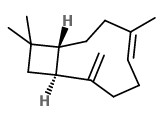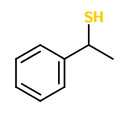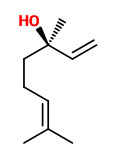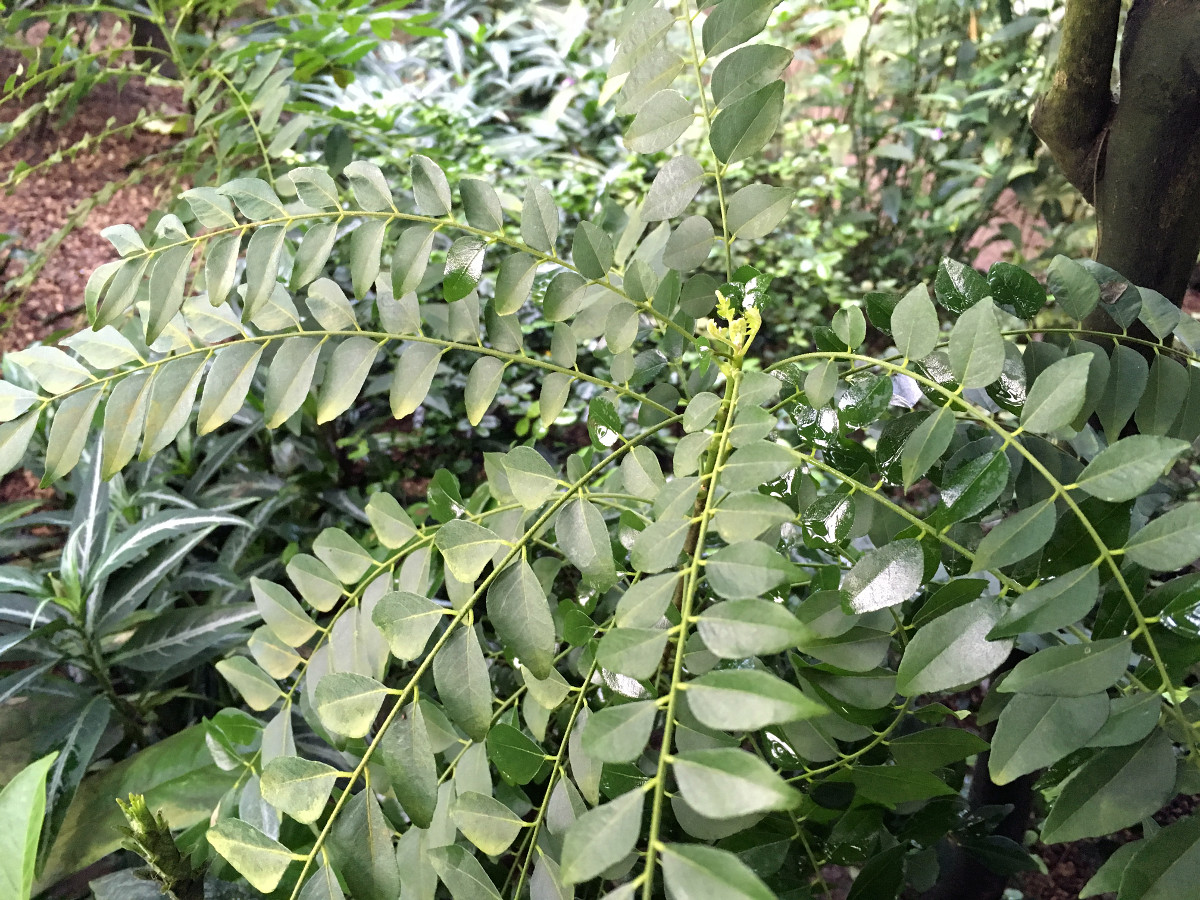Benutzer-Werkzeuge
Murraya koenigii (L.) Sprengel - syn. Bergera koenigii L. - Rutaceae - Indian curry tree, curry leaf, Indischer Currybaum, Curryblatt, Curryblätter
Shrub or small tree, up to 6m high, native to India and Sri Lanka; leaves pinnate, leaflets 11-31, ovate, 2-5cm; flowers fragrant, petals white, oblanceolate to oblong, 5-7mm; fruit bluish black, ovoid to oblong, 1-1.5 cm, 1- or 2-seeded. http://www.efloras.org/florataxon.aspx?flora_id=2&taxon_id=200012463
„Its leaves are used in many dishes in India and neighbouring countries. Often used in curries, the leaves are generally called by the name „curry leaves“, though they are also translated as „sweet neem leaves“ in most Indian languages (as opposed to ordinary neem leaves which are bitter).“ http://en.wikipedia.org/wiki/Curry_tree
„Sensory quality: Fresh and pleasant, remotely reminiscent of tangerines… The English term curry is of Indian origin: In Tamil, the most important South Indian language, the word kari [கறி] means „soup“ or „sauce“; this is also the basis of the Tamil name for curry-leaves, kariveppilai [கறிவேப்பிலை] which contains ilai [இலை] „leaf“. In English usage, curry has a wider meaning encompassing not only spicy foods of various kinds, but also Indian-style spice mixtures („curry powder“).
Curry leaves are extensively used in Southern India and Sri Lanka (and are absolutely necessary for the authentic flavour), but are also of some importance in Northern India. Together with South Indian immigrants, curry leaves reached Malaysia, South Africa and Réunion island. Outside the Indian sphere of influence, they are rarely found… For cooking purposes, the leaflets are usually torn from the rib to facilitate eating; in recipes, „ten curry leaves“ more often than not refers to ten leaflets, or about one half to one full leaf. Since curry leaves lose their delicate fragrance soon after drying, you should try to obtain them fresh; don’t waste your time with the dried stuff!“ http://gernot-katzers-spice-pages.com/engl/Murr_koe.html
Essential oil from leaves of M.koenigii growing in southern Nigeria was dominated by sesquiterpenes (89%). The main components were β-caryophyllene (20.5%), bicyclogermacrene (9.9%), α-cadinol (7.3%), caryophyllene oxide (6.4%), β-selinene (6.2%) and α-humulene (5.0%).
[Composition of the Leaf Volatile Oil of Murray a koenigii Growing in Nigeria., Onayade, O.A., Adebajo, A.C., Journal of herbs, spices & medicinal plants, 7(4), 2000, 59-66]
„The essential oil composition of four genetically diverse stocks of Murraya koenigii leaves cultivated at the CIMAP Research Farm, Lucknow, were analysed by GC and GC-MS. The oil from the stock of the northern Indian plains, Lucknow, showed β-pinene (70.0%), β-caryophyllene (6.5%) and α-pinene (5.4%) as the major constituents, while the oil from the stock of the lower Himalayan range, Pant Nagar, showed α-pinene (65.7%), β-pinene (13.4%) and β-phellandrene (7.4%) as the major constituents. In contrast to the above, the oil from the stock of southern India, Kozhikode, showed β-caryophyllene (53.9%), aromadendrene (10.7%) and α-selinene (6.3%) as the major constituents. On the other hand, the oil from the stock of eastern India, Bhubaneshwar, showed β-phellandrene (30.2%), β-caryophyllene (24.2%), α-pinene (15.0%), (E)-β-ocimene (5.0%) and aromadendrene (4.5%) as the major constituents. The GC-MS analysis of the stock oil samples from the northern Indian plains, lower Himalayan range, southern and eastern India resulted in the identification of 65, 56, 57 and 66, constituents, representing 99.2%, 98.8%, 87.4% and 98.2% of the oils, respectively.
The intense characteristic aroma of M. koenigii is probably due to terpene hydrocarbons and presumably the most important contributors are β-caryophyllene, β-gurjunene, β-elemene and β-phellandrene. In view of its caryophyllene content, the eastern genotype can be considered superior to the genotypes of the northern Indian plains (Lucknow,Uttar Pradesh) and the lower Himalayan range (Pant Nagar, Uttaranchal), but inferior to the southern Indian genotype. Due to presence of significant amounts of β-phellandrene (30.2%) and β-caryophyllene (24.2%), the leaf oil of the eastern genotype imparts a special flavour and can be widely used in the southern Indian dishes for the people of northern, eastern and western India, who are not very partial to the intense characteristic aroma of β-caryophyllene in the oil of M. koenigii from southern India, while people who are very fond of the intense characteristic aroma of M. koenigii should use leaves of the southern genotype only. On the basis of remarkable variation in the major and minor chemical constituents, all four genetically diverse
stocks can be concluded to be different chemotypes of M. koenigii.“
[Essential oil composition of genetically diverse stocks of Murraya koenigii from India. Raina, V. K., Lal, R. K., Tripathi, S., Khan, M., Syamasundar, K. V., Srivastava, S. K., Flavour and fragrance journal, 17(2), 2002, 144-146]
 β-caryophyllene |  β-phellandrene |  1-phenylethanethiol (sulfury, burnt) |  (Z)-3-hexenal |  α-pinene |  (R)-(-)-linalool |
Application of Aroma Extract Dilution Analysis (AEDA) to the volatile fraction of curry leaves afforded 23 odor-active compounds. Of the 22 odorants assigned, 15 had not been reported in curry leaves before. Highest FD factors showed 1-phenylethanethiol (8192), linalool (4096), α-pinene (2048), 1,8-cineole (1024), (3Z)-hex-3-enal (256), 3-(methylsulfanyl)propanal (128), myrcene (64), (3Z)-hex-3-en-1-ol (32), and (2E,6Z)-nona-2,6-dienal (32).
„The topmost OAVs were obtained for (3Z)-hex-3-enal (grassy; OAV 180 000), (1S)-1-phenylethane-1-thiol (sulfury, burnt; OAV 150 000), (1R)-1-phenylethane-1-thiol (sulfury, burnt; OAV 120 000), (3R)-linalool (citrusy; OAV 58 000), and myrcene (geranium leaf-like; OAV 23 000). The high OAVs calculated for its enantiomers confirmed 1-phenylethane-1-thiol as character impact compound of the typical sulfury and burnt aroma of curry leaves… The unique sulfury and burnt odor exhibited by 1-phenylethanethiol (67% R, 33% S) in combination with its high FD factor suggested that it constitutes the character impact compound of fresh curry leaf aroma.“
[Characterization of the Major Odor-Active Compounds in the Leaves of the Curry Tree Bergera koenigii L. by Aroma Extract Dilution Analysis., Steinhaus, M., Journal of agricultural and food chemistry, 63(16), 2015, 4060-4067]
„The 1-phenylethane-1-thiol concentration in curry leaves decreased upon tissue disruption and drying, as well as upon frying of fresh leaves. By contrast, frying of dried leaves led to an increase of 1-phenylethane-1-thiol, indicating a yet unknown thermolabile precursor.“
[Steinhaus, Martin. „Confirmation of 1-phenylethane-1-thiol as the character impact aroma compound in curry leaves and its behavior during tissue disruption, drying, and frying.“ Journal of Agricultural and Food Chemistry 65.10 (2017): 2141-2146]

Murraya koenigii (L.) Sprengel as Bergera koenigii L.
Roxburgh, W., Plants of the coast of Coromandel, vol.2, t.112 (1798)
http://plantgenera.org/species.php?id_species=683643

Murraya koenigii, Author: Andreas Kraska CC BY-SA 3.0
